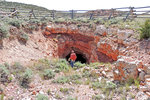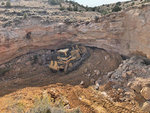Clear, 68° F
Three hazardous mines in the Bighorn Mountains that were abandoned a half-century ago were successfully reclaimed last year through the work of government agencies and private contractors.
From …
This item is available in full to subscribers.
The Powell Tribune has expanded its online content. To continue reading, you will need to either log in to your subscriber account, or purchase a subscription.
If you are a current print subscriber, you can set up a free web account by clicking here.
If you already have a web account, but need to reset it, you can do so by clicking here.
If you would like to purchase a subscription click here.
Please log in to continue |
|


Three hazardous mines in the Bighorn Mountains that were abandoned a half-century ago were successfully reclaimed last year through the work of government agencies and private contractors.
From the early 1950s through 1970, the Little Mountain area in the northern Bighorn Mountains experienced a period of uranium exploration and underground mining. The surface and underground disturbance caused by the mining was never reclaimed, the Bureau of Land Management reports, leaving behind numerous physical and radiological hazards.
However, the sites were reclaimed as part of what the BLM called a shared commitment between the agency and the State of Wyoming to enhance public safety and improve the health of public lands.
Contractors from Ten Sleep and Worland backfilled and closed all hazardous mine openings, backfilled sinkholes, plugged drillholes, reduced and removed dangerous highwalls and buried radioactive spoil piles and soils. A total of 80 acres of disturbances were recontoured, drainages re-established and all areas reseeded using native seed mixes suitable for the area.
“We’re pleased to have partnered with the State of Wyoming to remove the dangerous physical and radiochemical hazards from this heavily used recreation area, creating a safer environment for the public,” said BLM Cody Field Manager Cade Powell.
The Wyoming Department of Environmental Quality Abandoned Mine Land (AML) Division submitted the reclamation project proposal to the BLM. Four uranium mine sites were cleaned up, including the 40-acre Lisbon Mine site, the 20-acre Titan Mine site and two 10-acre Horseshoe Mine sites.
Funding for the roughly $800,000 project came through Wyoming’s AML program, which receives a portion of the fees collected on each ton of produced coal.
“We greatly appreciated the help and collaboration of the BLM Cody Field Office in completing this much needed reclamation project,” said Marcia Murdock of the Wyoming AML Division. “While there are many other abandoned mines remaining on Wyoming’s landscape that also require reclamation, our hope is that through cooperation with landowners, the BLM, and other land managers, we can make these sites safe for the visiting public, Wyoming’s citizens, and our wildlife.”
“Our work is not done,” Murdock added.
Reclamation of the mines also improved the health and habitat of the Little Mountain area, the BLM says. During a wildlife survey conducted prior to reclamation, as many as 13 bat species were documented to be present in and around the area of the Horseshoe Mine. The mine closure plan required ingress and egress protection measures be taken to preserve continued use of the mine by the bat populations residing there.